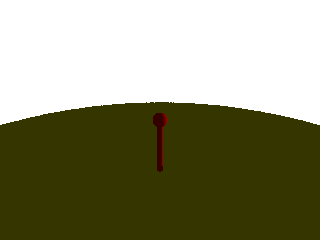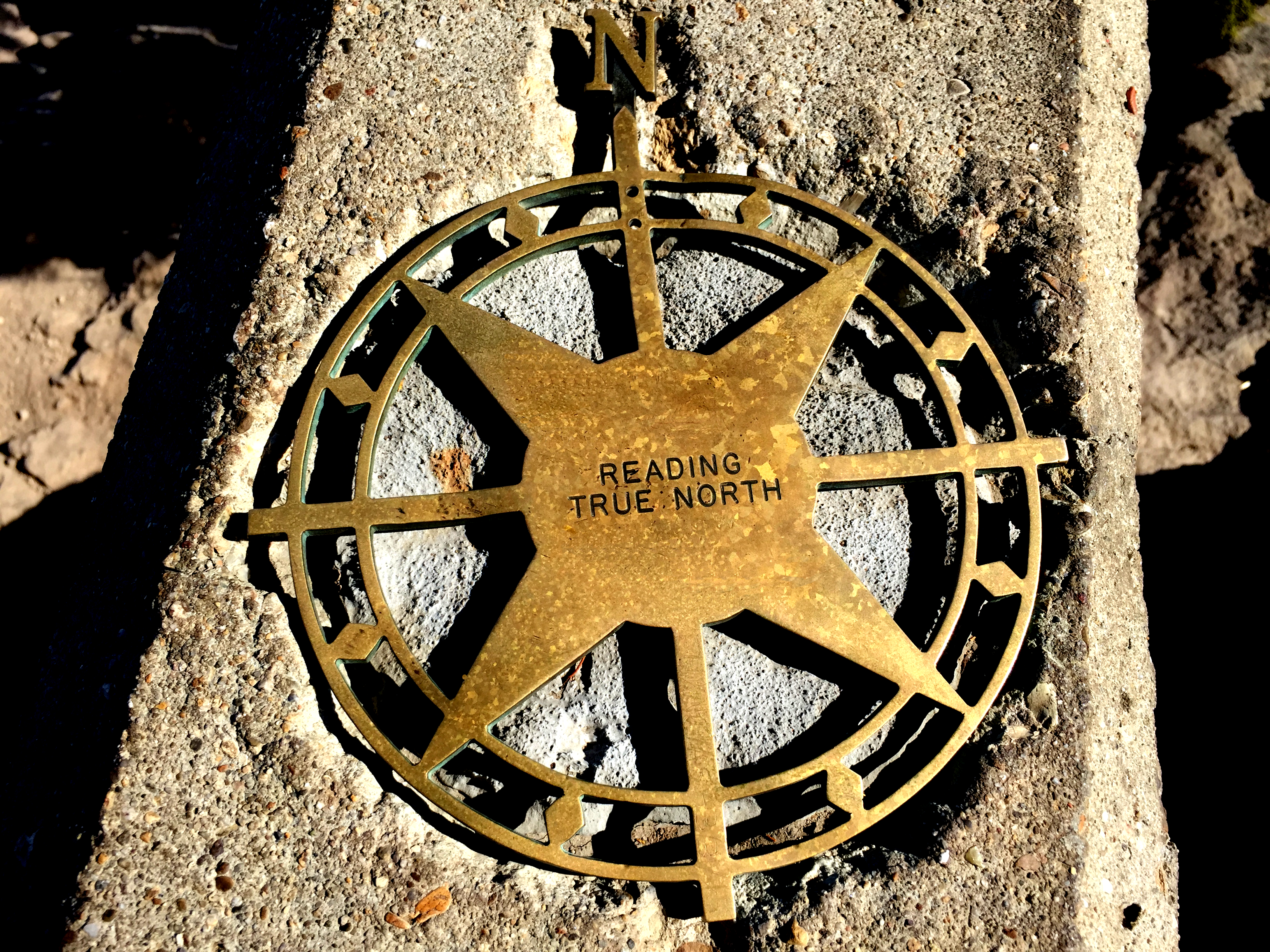|
Bearing (navigation)
In navigation, bearing or azimuth is the horizontal angle between the direction of an object and north or another object. The angle value can be specified in various angular units, such as degrees, mils, or grad. More specifically: * Absolute bearing refers to the clockwise angle between the magnetic north (''magnetic bearing'') or true north (''true bearing'') and an object. For example, an object to due east would have an absolute bearing of 90 degrees. Thus, it is the same as azimuth.U.S. Army, ''Advanced Map and Aerial Photograph Reading'', Headquarters, War Department, Washington, D.C. (17 September 1941), pp. 24-2/ref> * #Relative, Relative bearing refers to the angle between the craft's forward direction ( heading) and the location of another object. For example, an object relative bearing of 0 degrees would be immediately in front; an object relative bearing 180 degrees would be behind. Bearings can be measured in mils, points, or degrees. Thus, it is the same as ... [...More Info...] [...Related Items...] OR: [Wikipedia] [Google] [Baidu] [Amazon] |
Brunton
Brunton may refer to: Places *Brunton, Northumberland, England (near Alnwick) *Low Brunton, Northumberland, England (near Hexham) *Brunton, Wiltshire, England *Brunton Memorial Ground, Radlett, Hertfordshire, England *Brunton, Fife, Scotland; a List of United Kingdom locations: Bru-Bun, location in the U.K. Other uses *Brunton (surname) *Brunton, Inc., manufacturers of the Brunton compass See also *Colmar Brunton, a market research company *Brunton compass {{disambiguation, geo ... [...More Info...] [...Related Items...] OR: [Wikipedia] [Google] [Baidu] [Amazon] |
Angular Mil
A milliradian ( SI-symbol mrad, sometimes also abbreviated mil) is an SI derived unit for angular measurement which is defined as a thousandth of a radian (0.001 radian). Milliradians are used in adjustment of firearm sights by adjusting the angle of the sight compared to the barrel (up, down, left, or right). Milliradians are also used for comparing shot groupings, or to compare the difficulty of hitting different sized shooting targets at different distances. When using a scope with both mrad adjustment and a reticle with mrad markings (called an "mrad/mrad scope"), the shooter can use the reticle as a ruler to count the number of mrads a shot was off-target, which directly translates to the sight adjustment needed to hit the target with a follow-up shot. Optics with mrad markings in the reticle can also be used to make a range estimation of a known size target, or vice versa, to determine a target size if the distance is known, a practice called "milling". Milliradians ... [...More Info...] [...Related Items...] OR: [Wikipedia] [Google] [Baidu] [Amazon] |
Map Projection
In cartography, a map projection is any of a broad set of Transformation (function) , transformations employed to represent the curved two-dimensional Surface (mathematics), surface of a globe on a Plane (mathematics), plane. In a map projection, coordinates, often expressed as latitude and longitude, of locations from the surface of the globe are transformed to coordinates on a plane. Projection is a necessary step in creating a two-dimensional map and is one of the essential elements of cartography. All projections of a sphere on a plane necessarily distort the surface in some way. Depending on the purpose of the map, some distortions are acceptable and others are not; therefore, different map projections exist in order to preserve some properties of the sphere-like body at the expense of other properties. The study of map projections is primarily about the characterization of their distortions. There is no limit to the number of possible map projections. More generally, proje ... [...More Info...] [...Related Items...] OR: [Wikipedia] [Google] [Baidu] [Amazon] |
Grid North
A projected coordinate systemalso called a projected coordinate reference system, planar coordinate system, or grid reference systemis a type of spatial reference system that represents locations on Earth using Cartesian coordinate system, Cartesian coordinates (''x'', ''y'') on a planar surface created by a particular map projection. Each projected coordinate system, such as "Universal Transverse Mercator WGS 84 Zone 26N," is defined by a choice of map projection (with specific parameters), a choice of geodetic datum to bind the coordinate system to real locations on the earth, an origin point, and a choice of unit of measure. Hundreds of projected coordinate systems have been specified for various purposes in various regions. When the first standardized coordinate systems were created during the 20th century, such as the Universal Transverse Mercator, State Plane Coordinate System, and British National Grid, they were commonly called ''grid systems''; the term is still common ... [...More Info...] [...Related Items...] OR: [Wikipedia] [Google] [Baidu] [Amazon] |
Grid Azimuth
An azimuth (; from ) is the horizontal angle from a cardinal direction, most commonly north, in a local or observer-centric spherical coordinate system. Mathematically, the relative position vector from an observer ( origin) to a point of interest is projected perpendicularly onto a reference plane (the horizontal plane); the angle between the projected vector and a reference vector on the reference plane is called the azimuth. When used as a celestial coordinate, the azimuth is the horizontal direction of a star or other astronomical object in the sky. The star is the point of interest, the reference plane is the local area (e.g. a circular area with a 5 km radius at sea level) around an observer on Earth's surface, and the reference vector points to true north. The azimuth is the angle between the north vector and the star's vector on the horizontal plane. Azimuth is usually measured in degrees (°), in the positive range 0° to 360° or in the signed range -180° ... [...More Info...] [...Related Items...] OR: [Wikipedia] [Google] [Baidu] [Amazon] |
Nautical Chart
A nautical chart or hydrographic chart is a graphic representation of a sea region or water body and adjacent coasts or river bank, banks. Depending on the scale (map), scale of the chart, it may show depths of water (bathymetry) and heights of land (topography), natural features of the seabed, details of the coastline, navigational hazards, locations of natural and human-made aids to navigation, information on tides and Ocean current, currents, local details of the Earth's magnetic field, and human-made structures such as harbor, harbours, buildings, and bridges. Nautical charts are essential tools for marine navigation; many countries require vessels, especially commercial ships, to carry them. Nautical charting may take the form of charts printed on paper (raster navigational charts) or computerized electronic navigational charts. Recent technologies have made available paper charts which are printed "on demand" with cartographic data that has been downloaded to the commercial ... [...More Info...] [...Related Items...] OR: [Wikipedia] [Google] [Baidu] [Amazon] |
Bearing Compass
A bearing compass, is a nautical instrument used to determine the Bearing (navigation), bearing of observed objects. (Bearing: angle formed by the north and the visual to a certain object in the sea or ashore). Used in navigation to determine the angle between the direction of an object and the magnetic north or, indirectly relative to another reference point. Provides the absolute bearing, which is the clockwise angle between magnetic north or true north and the object. For example, an object to the east would have an absolute bearing of 90º, if it is relative to the magnetic north than it is called magnetic bearing. It is commonly used by geologists and surveyors to obtain precise bearings on the ground. Sailor, Sailors use successive demarcations of fixed Reference point (physics), reference points along with simple geometric techniques to determine their position, course and speed. In addition, making successive demarcations of other vessels, together with simple geometry te ... [...More Info...] [...Related Items...] OR: [Wikipedia] [Google] [Baidu] [Amazon] |
Magnetic North
The north magnetic pole, also known as the magnetic north pole, is a point on the surface of Earth's Northern Hemisphere at which the planet's magnetic field points vertically downward (in other words, if a magnetic compass needle is allowed to rotate in three dimensions, it will point straight down). There is only one location where this occurs, near (but distinct from) the geographic north pole. The Earth's Magnetic North Pole is actually considered the "south pole" in terms of a typical magnet, meaning that the north pole of a magnet would be attracted to the Earth's magnetic north pole. The north magnetic pole moves over time according to magnetic changes and flux lobe elongation in the Earth's outer core. In 2001, it was determined by the Geological Survey of Canada to lie west of Ellesmere Island in northern Canada at . It was situated at in 2005. In 2009, while still situated within the Canadian Arctic at , it was moving toward Russia at between per year. In 2013, t ... [...More Info...] [...Related Items...] OR: [Wikipedia] [Google] [Baidu] [Amazon] |
True North
True north is the direction along Earth's surface towards the place where the imaginary rotational axis of the Earth intersects the surface of the Earth on its Northern Hemisphere, northern half, the True North Pole. True south is the direction opposite to the true north. It is important to make the distinction from ''magnetic'' north, which points towards North magnetic pole, an ever changing location close to the True North Pole determined Earth's magnetic field. Due to fundamental limitations in map projection, true north also differs from the grid north which is marked by the direction of the grid lines on a typical printed map. However, the geographic coordinate system, longitude lines on a globe lead to the true poles, because the three-dimensional representation avoids those limitations. The celestial pole is the location on the imaginary celestial sphere where an imaginary extension of the rotational axis of the Earth intersects the celestial sphere. Within a margin of ... [...More Info...] [...Related Items...] OR: [Wikipedia] [Google] [Baidu] [Amazon] |
Clockwise
Two-dimensional rotation can occur in two possible directions or senses of rotation. Clockwise motion (abbreviated CW) proceeds in the same direction as a clock's hands relative to the observer: from the top to the right, then down and then to the left, and back up to the top. The opposite sense of rotation or revolution is (in Commonwealth English) anticlockwise (ACW) or (in North American English) counterclockwise (CCW). Three-dimensional rotation can have similarly defined senses when considering the corresponding angular velocity vector. Terminology Before clocks were commonplace, the terms " sunwise" and "deasil", "deiseil" and even "deocil" from the Scottish Gaelic language and from the same root as the Latin "dexter" ("right") were used for clockwise. " Widdershins" or "withershins" (from Middle Low German "weddersinnes", "opposite course") was used for counterclockwise. The terms clockwise and counterclockwise can only be applied to a rotational motion once a side ... [...More Info...] [...Related Items...] OR: [Wikipedia] [Google] [Baidu] [Amazon] |
Azimuths And Bearings
An azimuth (; from ) is the horizontal angle from a cardinal direction, most commonly north, in a local or observer-centric spherical coordinate system. Mathematically, the relative position vector from an observer (origin) to a point of interest is projected perpendicularly onto a reference plane (the horizontal plane); the angle between the projected vector and a reference vector on the reference plane is called the azimuth. When used as a celestial coordinate, the azimuth is the horizontal direction of a star or other astronomical object in the sky. The star is the point of interest, the reference plane is the local area (e.g. a circular area with a 5 km radius at sea level) around an observer on Earth's surface, and the reference vector points to true north. The azimuth is the angle between the north vector and the star's vector on the horizontal plane. Azimuth is usually measured in degrees (°), in the positive range 0° to 360° or in the signed range -180° to ... [...More Info...] [...Related Items...] OR: [Wikipedia] [Google] [Baidu] [Amazon] |




